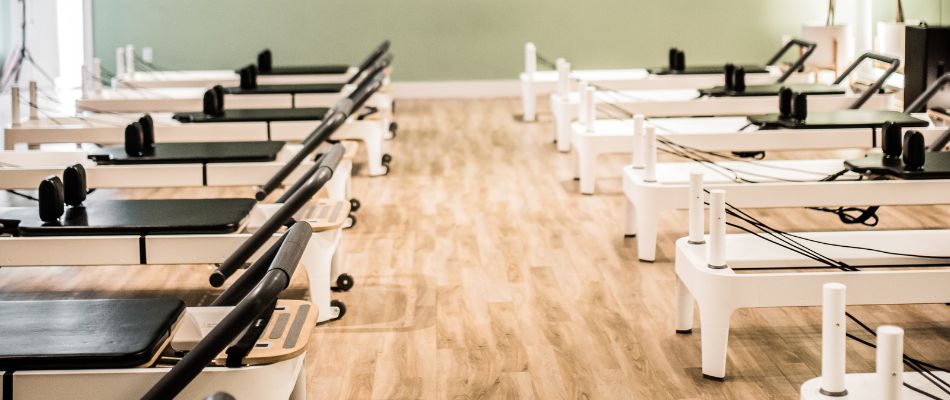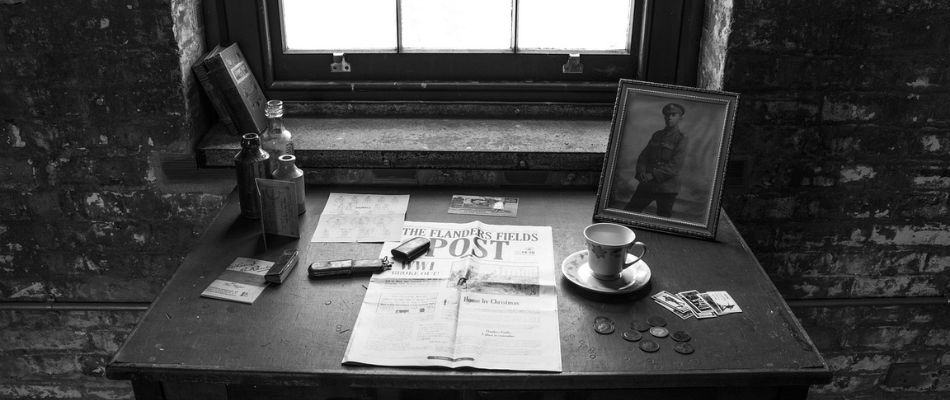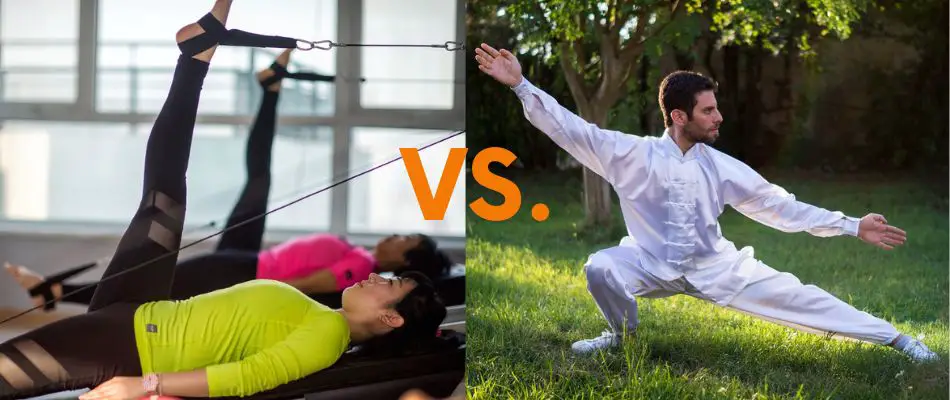Many people arrive at the doors of alternative practices like tai chi and Pilates because there is an aspect of their health that they want to dramatically change. Some want to get healthy in a holistic way. Some have received dire predictions from their doctors and are seeking an alternative before agreeing to medication, surgery, or injections. And others feel failed by Western medicine and see Eastern practices as their last hope. While both arts have a great track record for healing, improving wellness, and reducing pain, knowing the difference between tai chi vs Pilates is important because they achieve these positive outcomes in very different ways.
Tai chi and Pilates are alternative practices that improve posture, core strength, balance, reduce stress in the shoulders and neck, and can increase mobility. They differ considerably in how they achieve these goals. Tai chi is a series of choreographed slow movements with an emphasis on breathwork and mental clarity. Pilates is a series of teacher-led exercises performed on a mat that can include the use of equipment.
With so many people benefitting from both practices, choosing between tai chi vs pilates largely comes down to personal preference, physical limitations, budget, time commitment, and availability. What will get you the results in either case is consistency. And what will make you consistent is finding something that you enjoy and something that is the right fit from the beginning. So let’s compare the two so you can get out there and try a tai chi or Pilates class near you.
An In Depth Comparison of Tai Chi vs Pilates to Help You Choose Between the Two
| Tai Chi | Pilates | |
|---|---|---|
| Goals of the Art and Practitioner | Better posture Balance Relief from pain Reduction in stress Improved mood and outlook Social connection Improved flexibility Improved mobility Better sleep Increasing the body’s energy for immunity and healing | Better posture Balance Strong core Improved flexibility Toned stomach, gluts, and legs Relief from lower back pain Improved performance in a primary sport or activity |
| Class Description | A 30-90 minute class moving around a large space or outside. Typically led by a teacher. Larger classes broken into ability groups. | A 30-50 minute session on the floor or using equipment. Typically led by a teacher, using pulleys, balls, mats, and posture suggestions to strengthen the core and elongate the spine. |
| Price | On average, $10 per class. Free options available. | On average, $30-50 per class. |
| Availability | Introductory courses available online. Available almost everywhere. | Introductory courses available online. Typically available in larger cities. |
| Need for Equipment | No equipment needed unless learning weapons forms. | Some introductory exercises can be done on the floor. Otherwise equipment like balls, mats, and specialized rings needed. Machines like the Reformer only available in a class. |
| Time Commitment | Can be practiced for any amount of time. Progress best made with 1-2 practices per week. More time needed at the beginning to learn the movements of the form. Form can then be practiced in 5-20 minutes depending on style. | Suggested to attend 1-3 classes per week. Low commitment for learning as attendees are led through movements. |
| Need for a Teacher | Best learned from an instructor. Options exist to learn introductory material on your own. Can be practiced alone. | Best learned from an instructor. Options exist to learn introductory material on your own. Can be practiced alone. A class and teacher is needed for non-intro classes because of complex instruction and need for equipment. |
| Personal Preference | Classes are in groups, performed in well-lit rooms or outside. Attendees train and interact with others. Classes primarily focus on the movements but can also include history, language, and philosophy. | Classes are often relaxing with dim lights and music. Attendees work alone and get corrections from instructors. Classes focus on the movements. |
| Physical Limitations | Modifiable for all injuries, health concerns, and ages. Tai chi forms and meditations can be modified for everyone. Some weapons forms (spear, long pole) and push hands not suitable for everyone. | Modifiable for many injuries. Advanced postures and material cannot be performed by everyone. |
Comparing Tai Chi Vs Pilates Using the 8 Principles of Pilates
With such vastly different histories, it begs the question:
Why are tai chi and pilates compared?
The quick answer is that tai chi and Pilates share 5 specific outcomes:
- Improved balance
- Movement from the center
- Improved or lengthening of the breath
- Better posture
- Improved flexibility and mobility
How they get there is radically different though. In honor of Joseph Pilates’ work, let’s use his eight principles of development to discuss the distinctions between tai chi vs pilates.
Alignment
Body alignment and posture are critical in both tai chi and pilates. This is one area where the two arts overlap almost completely. Attention is paid to alignment before entering a posture and maintained the entire time. The goal is that improvements during class are carried out into the typical day.
Where the arts differ on alignment is that Pilates stretches into better posture and this is maintained in a static hold. Tai chi is continually moving so the focus on alignment happens during stepping, bending, squatting, and standing.
Breath
I think that the focus on breathing is one of the main reasons that yoga, tai chi, and pilates are seen in the same light. Very few western health activities focus on elongating the breath, using the full capacity of the lungs and diaphragm, and holding your breath to balance levels of oxygen (inhaled) and carbon dioxide (exhaled).
Both arts recognize the influence that full breaths have on our mood, energy level, and posture. Both arts also educate students on how shallow breath is associated with fear, bad posture, fatigue, and poor mood. Also, that the breath is typically held when we are experiencing negative emotions or new activities and this needs to be corrected. Due to tai chi’s longer history and relationship to meditation, breath is also manipulated for cognitive, physical, and emotional benefits. I believe Pilates practitioners benefit in the same way but just don’t necessarily discuss it.
Centering
Centering is highly important for both arts but is defined and accomplished in opposite ways. Centering is bringing focus and intention to the middle of the body behind the navel. The outcome is that the body is not off-balance and a person’s concentration is down within the body rather than trailing off on unrelated thoughts or traveling around the room. Centering has the secondary benefit of connecting you to the ground and aiding in good posture.
Pilates practitioners focus on the navel and engage the muscles of the stomach to “suck in their gut.” This inward pressure stabilizes and elongates the spine. It also provides balance when manipulating their equipment or stretching with bands.
Tai chi’s concept of centering places attention on the space central to the body behind the navel known as the lower dantian. However, you would never flex the stomach muscles but instead relax them, relax the lower back, and expand the area as you elongate up through the head and dawn through the feet. During certain tai chi movements, the abdominal muscles are used to manipulate the core by circling them, which has the added health benefit of massaging the organs. Think slow belly-dancing.
Concentration
Pilates and tai chi are great at pulling the mind out of the troubles of daily life and concentrating for a short period on the body, breath, surroundings, and present experiences. Pilates differentiates itself from other aerobic arts for this very reason. Pilates is not an escape or a time to let your mind wander. You are actively concentrating throughout the session and staying present.
Tai chi accomplishes this through staying present on the form and focusing on the order of the movements. Additionally, concentration is enhanced with the slow, precise nature of each movement. Students are taught continual awareness of anything they are feeling in their body and learn to be mindful of the position of each body part. This concentration in both arts shouldn’t be misconstrued as exhausting. Practitioners of both arts leave class feeling more aware and awake.

Control
If you are considering tai chi vs pilates, control is an area that the two practices differ wildly. Pilates works to build muscle and flexibility through holding difficult postures and flexing the muscles of the torso and stomach. It has bands, benches, and machines to aid in this. A stated goal of many Pilates classes is toned thighs, gluts, and visibly strong abs.
Tai chi is a constant battle to learn to relax fully. This includes a fully relaxed belly. It’s not the most flattering look but stomach muscles are instead manipulated to take longer breaths and massage the organs through movement.
Some Pilates instructors interpret the teachings of Control in the way that tai chi conceptualizes awareness. Meaning, that there is a continual presence of mind during every exercise, between every breath and hold, when you are getting on and off equipment, or down and up from the mat. In this regard the two arts are similar. However, I don’t know that Pilates teaches this with the intention of integrating it with how we are moving throughout the entire day. I think it’s there inherently, but not explicitly taught.
Precision
I really like Pilates’ thoughts on Precision because it is a rare SEPARATION for a western art to consider how your small movements, postures, and habits can lead to pain, irritation, and injury. In tai chi, a negative sensation like a knot in the shoulder is considered communication from the body telling you that something needs to be fixed. Pain is not comfortable and we don’t have to like it. But how else can your body tell you when something is wrong? Pain or discomfort is this message and the way we “listen” is through precision.
Tai chi starts out being taught in a way that a student just learns the basic choreography. Over months and years it is refined down to perfect the large postures down to the tiny movements of the fingers. The slow nature of tai chi enables you to make subtle changes and improve for a lifetime.
Pilates focuses on perfection of posture, breath, and elongation to obtain precise postures and movements. This not only achieves the toned muscles and better posture they are after but sets a student up well to guard against injury down the road with the more difficult activities that are using bands to stretch and weighted objects.
Lastly, when comparing tai chi vs pilates, I think there is disagreement on these final two principles.
Integration
Integration for Pilates practitioners refers to using the body as a whole. Exercises done with the arms for instance, still require focus and expansion from the feet through the top of the head. Additionally, each session is seen as an integrated set of movements where attention is maintained as a person moves in and out of each activity. Lastly, that disease, fatigue, or pain is related to a disjointed use of the body. Therefore, by connecting to our core and strengthening it we regain integrated movement.
No arguments here from a tai chi standpoint. However, philosophically tai chi is a set of movements that reintroduce us to the natural flow of things around us and re-integrates us with the world as a whole. Separation from this un-integrated state leads to chaos, exhaustion, and a loss of equilibrium in parts of our life.
I see Pilates’ idea of integration as the first half of the goal of practicing tai chi. You learn about and sense integration on a personal and physical level first. Then you work to see and make this connection with every being and event around you outside of class. It’s really quite beautiful if you think about it and shouldn’t be understated. In tai chi you work to understand how similar you are from those around you leading to less conflict. You see your role in the world and choose behaviors that are less destructive. You integrate yourself with what is happening around you and learn acceptance leading to less emotional reactivity and suffering.
Flow
Flow is an important consideration in Pilates with the goal that the body moves freely into postures and at the end stabilizes by contracting the muscles with precision and control. When juxtaposed against yoga where many of the moves were borrowed from, Pilates might appear to flow rather than holding a static posture. But in the grand scheme of things, a practitioner is still holding a position, and often forcing themselves further into the position with the constrictive equipment.
Tai chi is movement. What separates beginners from avid practitioners is that they have internalized the continual, slow focus on flow to not disrupt the progression of their movements, breath, and weight shifts. Even in postures that appear to have stopped for a second, there is continual relaxation, sinking, and exhaling that is perceivable. The idea of flow is looked at from a health standpoint creating an activity that is opposite to a sedentary lifestyle. Lastly, flow is embodied conceptually to bring practitioners closer to the movement of nature that is continual, such as the wind moving the grass or a flowing stream.

The Origin of Tai Chi vs Pilates’ Early Days
With tai chi, pilates, and yoga being grouped together as similar alternatives, I think it’s important to end by sharing a bit about Pilate’s history. It’s fascinating in its own right but very different from the other arts. The origins of tai chi go back thousands of years and the development of tai chi is attributed to several distinct lineages and families. The movements are based on philosophical ideas and there is a connection between your practice and the world at large.
Pilates on the other hand was developed by a single person during the early 1900s for completely different reasons. Joseph Pilates was German-born and became interested in fitness initially to get past physical ailments like asthma. By all accounts he not only overcame poor health but developed extraordinary health. After moving to England in 1912 is when things began to get interesting. He earned his living boxing, performing in the circus, and training the police at Scotland Yard in self defense. But it wasn’t until he was interned during World War I for being of German descent that the practice of Pilates started to take shape.
Joseph Pilates instructed other interned men in fitness regimens, studied aspects of gymnastics, yoga, and the movements of animals to create a series of exercises that focused on strengthening the muscles of the torso and improving posture. There are even anecdotes about him using the springs and pieces of the beds from the infirmary to lay the groundwork for the equipment that pilates is famous for.
In the 1920s he moved to the United States, opened a studio, and became famous among the art crowd as his practices rehabilitated and improved the movements of dancers. He published his theories in his book Return to Life Through Contrology and the success that the first students enjoyed was further spread as his top students became instructors.
Joseph passed away in the 1960s but his legacy is enormous. Pilates, the practice, is now known throughout the world for helping athletes and active people perform better, rehabilitate specific injuries, and improve posture and core strength.



